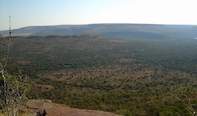The Existence of Morokweng
The crater record of Earth is continually expanding as new impact structures are identified. A case in point - Morokweng Crater can be found buried beneath the desert sands near Vryburg in North West Province.

The existence of Morokweng was first proposed by researchers in 1995. They were doing some magnetic and gravimetric surveys of a well-known subterranean curiosity that was then known as the Ganyesa Dome, located in the Kalahari Desert on the border with Botswana. As with many other impact sites, it was originally thought that this circular feature was a result of volcanic activity.
However, core samples taken from the area showed that there were shock metamorphics and melt rock present at the site. Subsequent investigations showed that the rock also contained a relatively high concentration of meteoric minerals. Morokweng was clearly an impact structure.
This fact was conclusively proven when, in 2006, a 25cm piece of the original meteorite was found at a depth of 770m. No other large-scale impact structure has yet revealed such a big piece of intact meteorite.
Morokweng Crater Size and Impact
The exact size of the Morokweng Crater is difficult to determine as it is wholly covered by newer rocks and sand. Current estimates put it at around 70 km, making it one of the more substantial impact events in the planet’s history.
The date of Morokweng is also interesting, as it is said to have been created around 145 million years ago. This corresponds quite closely with a small but significant mass extinction that marked the transition between the Jurassic and Cretaceous periods (the so-called J-K boundary). It is possible, but not confirmed, that the Morokweng impact played a role in this extinction.
Morokweng Crater is in a remote part of South Africa and is not really accessible to the general public. However, several fragments of the meteorite which created the crater are on display in London’s Science Museum.